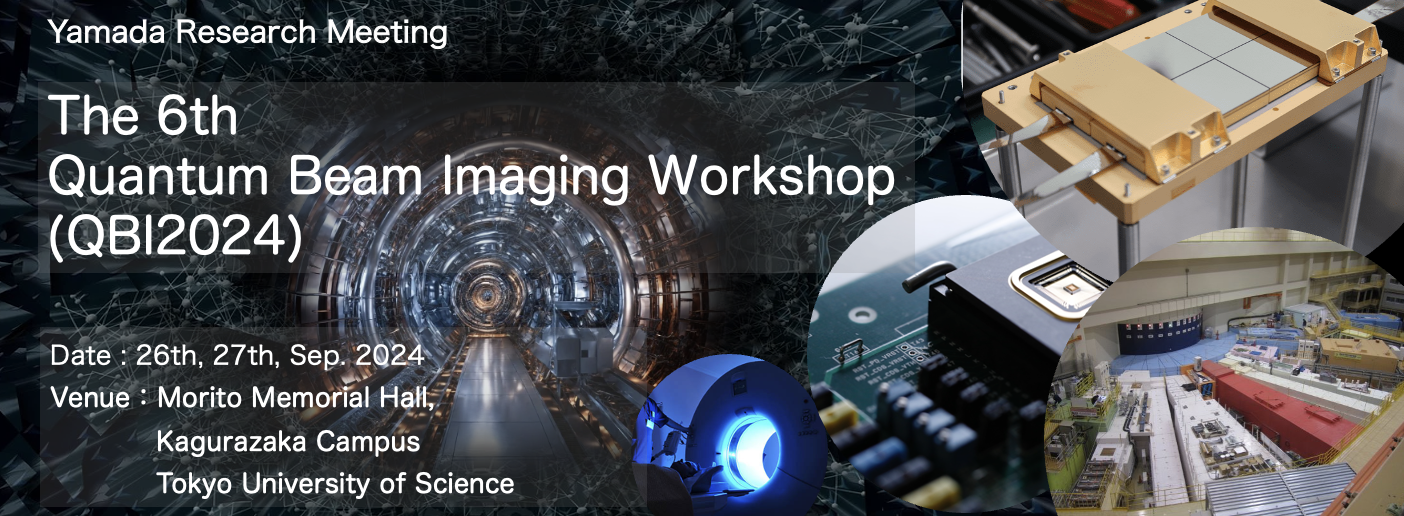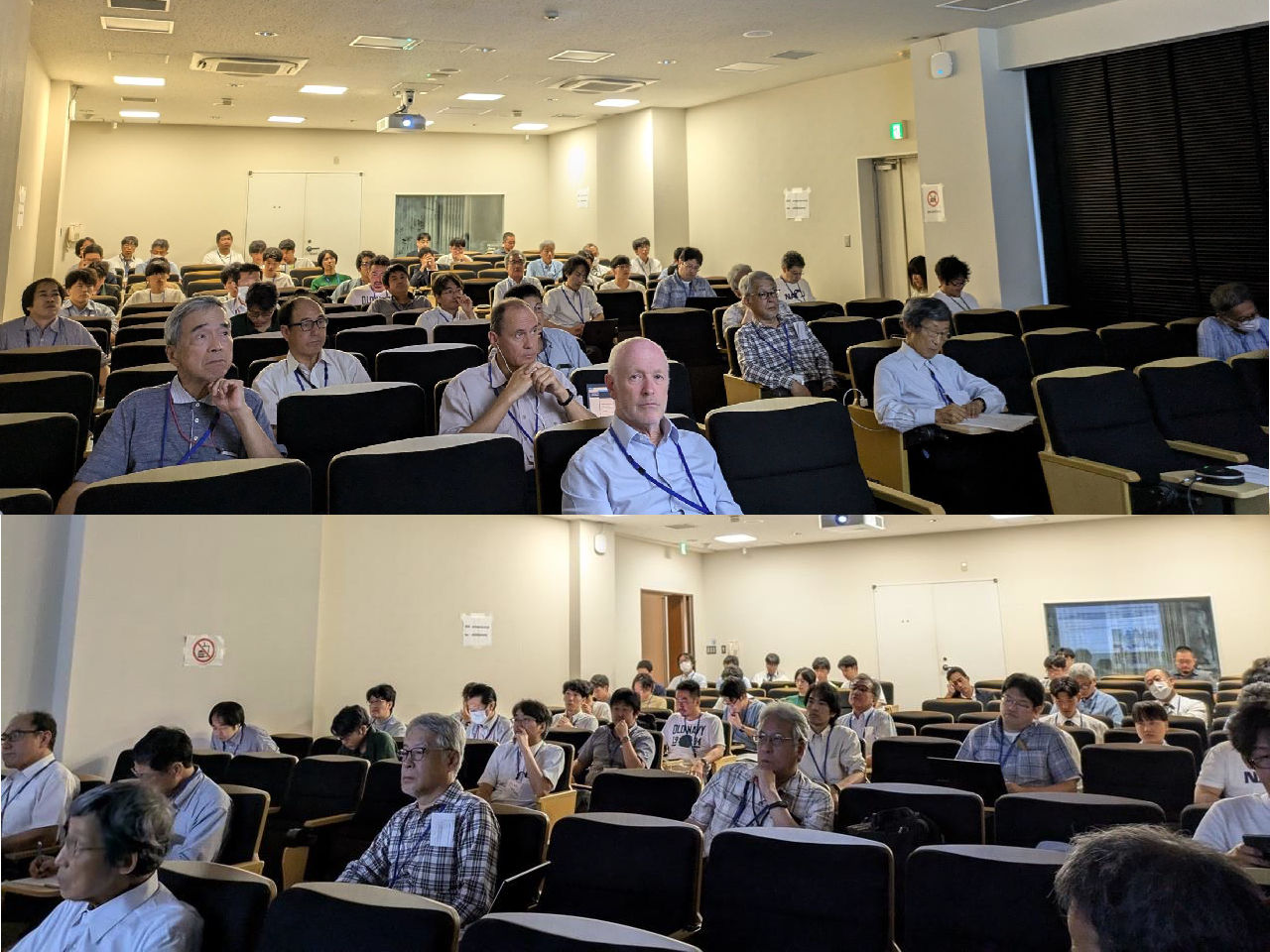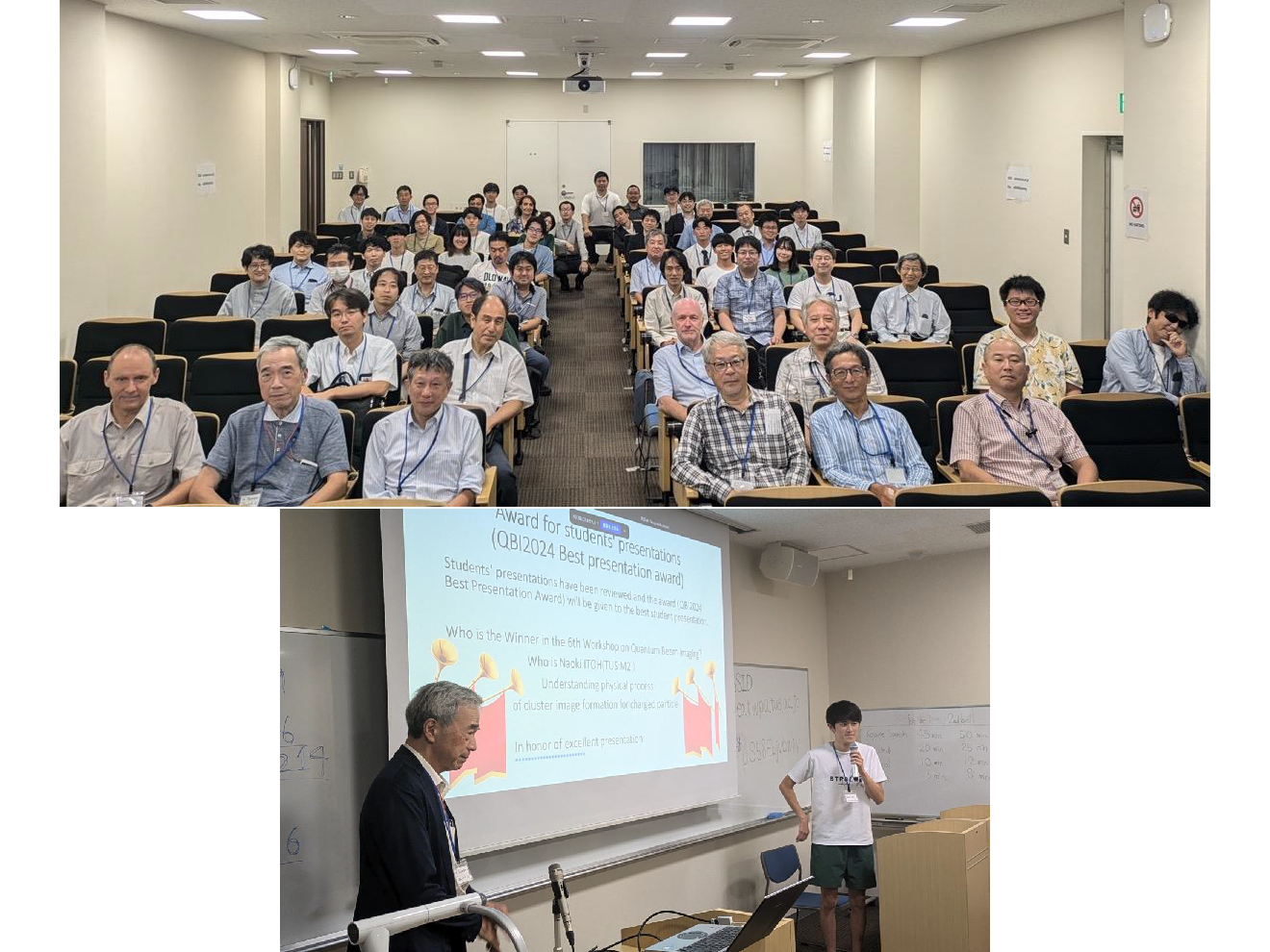
 |
 |
The Best Student Presentation Award was given to Mr. Naoki Ito, a second-year student in the Department of Advanced Physics, Tokyo University of Science. Congratulations!
The next QBI2025 will be held at Shizuoka University. We look forward to your participation.
Yamada Research Meeting. The 6th Quantum Beam Imaging Workshop(QBI2024)
Scientific and technological advancements in detecting and analyzing quantum rays, such as photons (including infrared, X-rays, and gamma rays), electrons, neutrons, molecules, and ions, have significantly contributed to various fields. These fields range from particle and nuclear physics, astrophysics, and materials science to life sciences and medicine. In recent years, imaging detection technologies in these areas have undergone remarkable progress. Simultaneously, collaborations across science, engineering, industry, and academia have deepened, leading to continuous new developments.Against this backdrop, we have established this workshop with the theme of "Quantum Beam Imaging (QBI)" to foster cross-disciplinary discussions aimed at advancing science and technology and creating new fields. This workshop aims to share the latest research results and technologies, promote exchanges between different fields, and stimulate new ideas and collaborations.
Participants will include a wide range of individuals, from young researchers, including graduate students, to active researchers in their respective fields, as well as senior researchers leading research groups. Furthermore, the workshop is open to participants from academic fields and researchers from the industrial sector aiming for practical applications. Regarding presentations, we expect participants to share cutting-edge results from their fields, explore the applicability of principles and know-how unique to each field, and identify commonalities with other fields. Since the audience may include those who understand the principles of physics but are not experts in specific areas, please provide necessary introductions accordingly. If you believe it is beneficial to explain applications in related fields, a concise overview would be appreciated. This year's workshop will be held at the Kagurazaka Campus of Tokyo University of Science.
We look forward to your active participation. Outstanding presentations by students will be awarded the Best Presentation Award. Lastly, we would like to express our gratitude to the Yamada Science Foundation for their support in organizing this workshop.
Scope
This conferce covers the recent progress of X-ray, gamma-ray, visible light, infrared and particle detectors and their applications in high-energy physics, astronomy, medicine, etc including the following fields:
Detectors
sensors for tracking
sensors for imaging
pixel, strip, avalanche-based sensors
gas detectors
scintillation detectors
Application and Methods
Applications in astrophysics
Applications in biology, medicine, medical equipments
New ideas and future applications
Others
ASICs
Detector concepts
Radiation damage and radiation tolerant materials
Date and venue
Date : 26th (Thu), 27th (Fri) Sep. 2024
Registration Fee : Free
Venue:Forum 1, Morito Memorial Hall, Kagurazaka Campus, Tokyo University of Science
Deadline:Friday, Aug 31 for those who wish to speak Sep 24 for on site participate and zoom paticipants
Reception Date and Time :26,Sep, 19:30~
Reception venue :Royal Garden Cafe Iidabashi(https://royal-gardencafe.com/iidabashi/)
Reception :7000 Japanese Yen(General)、5000 Japanese Yen(Student) (Please pay at the reception desk at the workshop venue)
Abstract submission ( due date 8/31 ) & Registration ( due date 9/24 )
Programs
Presentation will be done in English or Japanese. It is recommended to preparare slides written in English.
Keynote Speakers
Andrew Holland (The Centre for Electronic Imaging, Open University and XCAM Ltd, UK)
In the late 1980's and early 1990's CCD technology was being developed for imaging X-ray spectroscopy for space telescopes, including ESAs XMM and NASAs Chandra observatories. In Europe, the MOS CCD developments were conducted with what is now Teledyne e2v UK (formerly EEV and e2v Technologies). High purity epitaxial and float zone silicon were explored to increase the high energy detection QE, whilst a variety of techniques; thin electrode, open electrode and back-illumination, were explored to increase the soft X-ray QE. These developments will be discussed which led to the creation of high performance focal plane arrays with "fano-limited" energy resolution. The space environment is harsh (and inaccessible) providing damage by space radiation and even micrometeorites. The performance of the XMM EPIC MOS cameras will be reviewed over their 25 years of operation in space. The CCD technologies developed have found many applications in other terrestrial and space applications, particularly in synchrotron research, and results of camera developments for FELs and RIXS will be covered. However, the detector technology has more-recently been moving toward CMOS image sensors. We are now developing advanced CMOS image sensors for the ESA Theseus mission concept which is (currently) one of 3 candidates for ESAs M7 opportunity. Here we are adapting many of the techniques applied to CCDs some decades earlier toward the development of new large area, high frame rate direct detection X-ray sensors, whilst retaining the goal of achieving near "Fano-limited" performance. Results of this exciting new development from the existing Phase 1 detector will be presented, with measurements achieving 127 eV FWHM at Mn-K operating at 20 fps, including space radiation damage assessments, where performance can be achieved at -40 degrees C compared to -100 degrees C for the CCD technology. At the time of writing this abstract, the work is about to enter its 2nd phase of development towards a 3-sides buttable device of 45x90 mm2 which should find many applications in coming years beyond that of the ESA candidate mission Theseus.
Anton S. Tremsin (Space Sciences Laboratory, University of California at Berkeley, USA)
Detectors with Microchannel Plates have found niche applications in soft X-ray UV and sometimes visible photon detection where event counting with high spatial and timing resolution is needed. Different types of readouts for these detectors have been developed over last several decades. The Timepix readout ASIC placed directly below MCP in the vacuum is one of the possible readout options. The capability of pixelated Timepix readout to detect many simultaneous events substantially increases the count rate capabilities of these devices to GHz levels. In this talk, we review the possible readout configurations for the MCP detectors and present the recent developments of this photon counting technology and present the results obtained with an MCP detector coupled to a quad Timepix/Timepix3 and a single-chip Timepix4 readouts. The spatial resolution of this detector can routinely reach ~6 µm values (the size of the MCP pores). This resolution is achieved in real time through the event cenrtoiding. Optimization of detector characteristics need to be performed in order to achieve such a high spatial resolution. Timing resolution of 1.6 ns with Timepix3 readout and is expected to be better than 200 ps with the latest generation Timepix4 readout. A couple of application examples of these detectors at Resonance Inelastic X-ray Scattering (RIXS) and X-ray Photon Correlation Spectroscopy demonstrate the unique capabilities of such devices for certain synchrotron-based experimental studies. Same MCP/Timepix detectors can be very attractive for the applications where the photon/electron/ion/neutron counting with high spatial and temporal resolution is required, such as Time of Flight experiments in energy-resolving neutron imaging at spallation neutron sources, fluorescence lifetime imaging and, if adapted for the electron detection, experiments on photoelectron spectroscopy.
Invited Speakers
・Hiroki Akamatsu(KEK, JP)「Cryogenic detector technology opens the way to new view of Universe」・Eisuke Abe(RIKEN, JP)「Development of superconducting quantum computers at RIKEN」
・Shinpei Ogawa(Mitsubishi Electric Corp, JP)「Graphene-based image sensors using photogating」
・Hiroaki Ohnishi(Tohoku University, JP)「Current status of research and development of imaging systems at RARiS, Tohoku Univ」
・Manabu Kanematsu(Tokyo University of Science, JP)「Use of neutron imaging in the construction field」
・Taku Gunji (CNS/QNSI, The University of Tokyo, JP)「Highlights from detector technologies for the Electron-Ion Collider experiment」
・Nobuyuki Kobayashi (RCNP, Osaka Universitym JP)「High-performance data acquisition system developed by SPADI-Alliance」
・Manabu Togawa(KEK, JP)「Development of highly radiation tolerant particle detectors using CIGS Semiconductors」
Time Tables
The time table for the workshop is as follows (2024.09.09).
| Day 1:Feb 26th(Thu) | ||
| Time | session | Approximate number of presentations |
|---|---|---|
| 13:00-13:05 | Takayoshi Kohmura(Tokyo Univ of Science) | Opening Remark |
| 13:05-13:15 | Takayuki Hamamoto(Tokyo Univ of Science) | Opening Greetings from the Chancellor of Tokyo Univ of Science |
| 13:15-14:15 | Andrew Holland (The Centre for Electronic Imaging, Open University and XCAM Ltd) |
Keynote Speech Development of High Performance Silicon X-ray Photon-Counting with Spectroscopy Detectors for Space and Synchrotron Science using CCD and CMOS Technology |
| 14:15-14:45 | Hiroaki Ohnishi(Tohoku Univ) | Invited Talk Current Status of Research and Development of Imaging Sensors at RARiS,Tohoku Univ |
| 14:45-15:00 | I-huan Chiu(JAEA) | General Talk Development of a boron imaging method for BNCT using CdTe-DSD |
| 14:40-14:55 | Break | |
| 15:15-15:45 | Manabu Togawa(KEK) | Invited Talk Development of Highly Radiation Tolerant Particle Detectors Using CIGS Semiconductors |
| 15:45-16:00 | Haruki Nishino(JASRI/RIKEN) | General Talk Development of 20.2 Mpixel CITIUS detector for SACLA |
| 16:00-16:10 | Sayumi Fujita(Tokyo Univ of Science) | Student Talk Evaluation of Radiation Tolerance of SOI Pixel Detectors for Onboard X-ray Astronomy Satellites |
| 16:10-16:20 | Takumi Kishimoto(Kinki Univ) | Student Talk Investigation of X-ray SOI-CMOS Image Sensor Performance in High Temperature Environments |
| 16:20-16:35 | Break | |
| 16:35-17:05 | Hiroki Akamatsu(KEK) | Invited Talk Cryogenic Detector Technology Pioneering New Cosmology |
| 17:05-17:20 | Dai Takei (Daiphys Technologies LLC) |
General Talk Unpixelized X-ray Imager of Position-Sensitive TESs |
| 17:20-17:50 | Eisuke Abe(RIKEN) | Invited Talk Development of Superconducting Quantum Computer at RIKEN |
| 17:50-18:00 | Yudai Shinohara(Shizuoka Univ) | Student Talk Crosstalk due to charge diffusion in SOI pixel sensors |
| 18:00-18:10 | Fumiya Shiga(Tokyo Univ of Science) | Student Talk Evaluation of X-ray response characteristics at sub-pixel scale of SOI pixel detector for X-ray astronomy introducing PDD structure |
| 18:10-18:20 | Yusuke Komura(Kyoto Univ) | Student Talk Current Status of Development of Drive Signal Pattern Generator in X-ray SOI Detector |
| 19:30-21:30 | Banquet | |
| Day 2:Sep 27th(Fri) | ||
| 09:00-10:00 | Anton S. Tremsin (Space Sciences Laboratory, University of California at Berkeley) |
Keynote Speech Recent progress in high resolution photon counting detectors with Microchannel Plates |
| 10:00-10:30 | Taku Gunji(CNS/QNSI Univ of Tokyo) | Invited talk Highlights from detector technologies for the Electron-Ion Collider experiment |
| 10:30-10:45 | Break | |
| 10:45-11:15 | Nobuyuki Kobayashi(RCNP Osaka Univ) | Invited talk High-performance data acquisition system developed by SPADI-Alliance |
| 11:15-11:30 | Fumitaka Endo(RCNP Osaka Univ) | General talk Development and application of active targets being irradiated with high intensity heavy ion beams |
| 11:30-11:40 | Ken Nishida(Univ of Tokyo) | Student talk Development of a Scintillation Detector and its Readout Circuit for Hypernuclear Spectroscopy Experiments |
| 11:40-11:50 | Kotaro Nishi(Univ of Tokyo) | Student talk Synchrotron Radiation Profiling in Undulator Synchrotron Radiation Interferometry for Electron Beam Energy Measurement |
| 11:50-12:00 | Naoki Ito(Tokyo Univ of Science) | Student talk Understanding physical process of cluster image formation for charged particle in TimePix3-Si detector |
| 12:00-12:10 | Taijyu Sugiyama(Saitama Univ/RIKEN) | Student talk Development of energy calibration method for GAGG(Ce) calorimeter |
| 12:10-13:30 | Lunch Break | |
| 13:30-14:00 | Manabu Kanematsu(Tokyo Univ of Science) | Invited talk Neutron Imaging Applications in Construction and Architecture |
| 14:00-14:15 | Abdul Muneem (Neutron Beam Technology Team, RIKEN) |
General talk Advancing Neutron Imaging Techniques to Highest Resolution with using Solid-State Track Detectors |
| 14:15-14:25 | Shin'ichi Kamada(Miyazaki Univ) | Student talk Neutron response evaluation of B-10 deposited SOI-CMOS pixel detector “XRPI" |
| 14:25-14:40 | Orsini Fabienne (RIKEN/SPring8 Center) |
General talk Limitations of CdTe detectors under continuous X-ray irradiation at high-energy synchrotron facility |
| 14:40-14:50 | Yuuki Furukawa(Tokyo Univ of Science) | Student talk Performance evaluation of 1mm-thick CdTe-DSD |
| 14:50-15:20 | Shinpei Ogawa(Mitsubishi Electric Corp) | Invited talk Graphene image sensor using optical gating effect |
| 15:20-15:35 | Break | |
| 15:35-15:45 | Hikaru Uebayashi(Kyoto Univ) | Student talk Development of a compact X-ray SOI camera for elemental mapping of the lunar surface |
| 15:45-15:55 | Leo Matsui(Kinki Univ) | Student talk Upper Atmosphere Observation Project “SUIM” using X-ray SOI-CMOS Image Sensor |
| 15:55-16:05 | Eisuke Kuroki(Miyazaki Univ) | Student talk Development of an X-ray camera to be installed in the Upper Atmosphere Observation Project “SUI"M |
| 16:05-16:15 | Joe Sato(Tokyo Univ of Science) | Student talk Evaluation of Double-side Si Strip Detector (DSSD) double-stacked module for direction-of-arrival measurement of cosmic-ray muons by angular reconstruction. |
| 16:15-16:30 | Ri'ichiro Nakamura(RIKEN) | General talk Ultra-compact imaging Cherenkov detector for lunar radiation environment monitoring~Lunar-RICheS~ |
| 16:30-16:45 | Hiroshi Tsunemi(Osaka Univ) | Student Awards Ceremony & Closing Remark |
| 17:30-18:00 | SOC Meeting | |
Reception information
Reception Date and Time :26,Sep, 19:30~
Reception venue :Royal Garden Cafe Iidabashi(https://royal-gardencafe.com/iidabashi/)
Reception fee :7000 Japanese Yen(General)、5000 Japanese Yen(Student) (Please pay at the reception desk at the workshop venue)
QBI2024 Scientific Organizing Committee
Hiroshi Tsunemi (Osaka University)Yasuo Arai(KEK)
Masataka Ohkubo(AIST)
Haruyoshi Katayama(JAXA)
Ikuo Kurachi(D&S)
Takayoshi Kohmura(Tokyo Univsesity of Science)
Tadayuki Takahashi(The University of Tokyo)
Takeshi Go Tsuru(Kyoto University)
Satoshi Nakamura(The University of Tokyo)
Takaki Hatsui(Riken)
Hironori Matsumoto(Osaka University)
Satoshi Miyazaki(NAOJ)
Keita Yasutomi(Shizuoka University)
Taiga Yamaya(QST)
